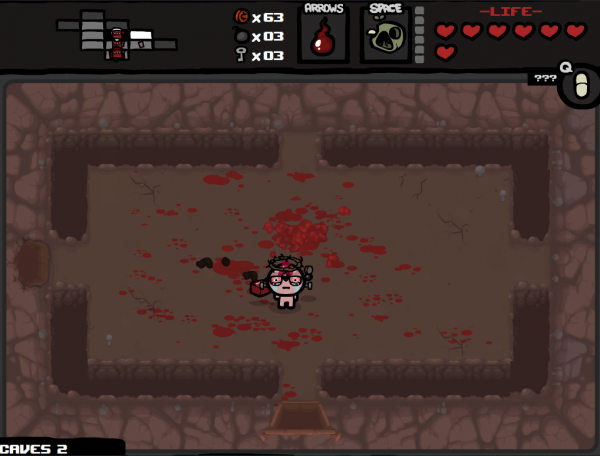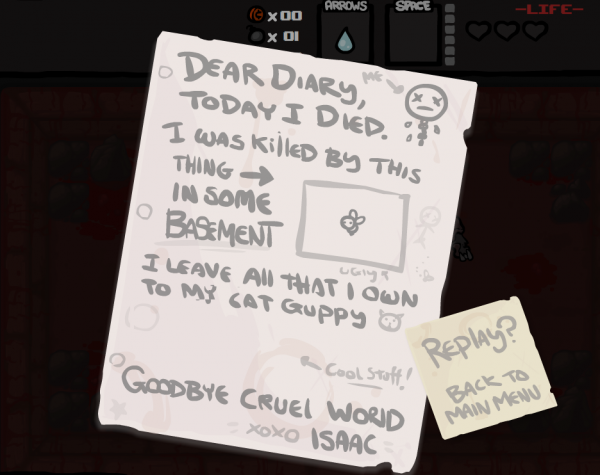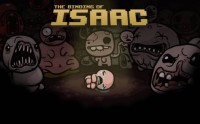I showed The Binding of Isaac to my nine year old brother. Only in passing, as some of the content in there, I wouldn’t want him to see. He said, “Is it like Zelda?” to which I replied, “Well, sort of.” I’m afraid there is going to be this sort of vague description of The Binding of Isaac throughout my review, as it is a weird beast. A hugely enjoyable one, but weird.
In the days prior to its release, the Binding of Isaac was described as many things. Rogue-like, Zelda-like, Smash TV-like… I feel none of these descriptions really hit the nail on the head, but I don’t feel as if I’m about to do it here either, so I’ll just do my best, I suppose.
The Binding of Isaac is based on a story in the Hebrew bible where Abraham, father of Isaac, was told by God to offer his son as a sacrifice to prove his faith. When I say ‘based’, I don’t mean that the game is some manner of retelling; just that you control Isaac, trying to ensure he doesn’t become a sacrifice. Here, however, it’s Isaac’s mother who God calls upon to end Isaac’s life, and so he escapes into the basement of their house. All of this is explained in a short prologue movie before you’re left to defend yourself against grotesque creatures, with only your tears for a weapon, at least until you get some upgrades, after which you could be flinging blood, purple energy and yes, even urine.

There are six floors (in your first playthrough anyway, you can unlock more levels after finishing the game) that Isaac must traverse. They are laid out in classic Zelda fashion, with an overhead view, a map composed of little rectangles and the doors shutting behind you until you clear out the room. These are randomly-generated dungeons with randomly-chosen enemies that have seemingly random properties. For example, the enemy in the next room may be one you’ve encountered before, but this one might just drop a bomb upon death. Maybe it’ll unleash some deadly flies, maybe it’ll drop a coin for you. As you encounter these enemies more (and you will encounter them a lot before you defeat the final boss), you’ll soon learn how to most effectively deal with them, but these random properties can still trip you up. This is where the rogue-like comparisons come in, the genre famous for their randomly-generated properties and perma-death style of gameplay.
Controls are simple enough and are explained nice and clearly every time you start a new game. WASD to move, arrow keys to fire, shift or E to drop a bomb, space to use rechargeable items and Q for expendable items. The controls worked for me, but might not work for others, and if that’s the case then I’m afraid to say that there is no way to rebind keys. In fact, there’s no way to change the controls at all, not even by using a gamepad. It feels like the game would work quite well with one too, so I find that decision odd, but already there have been many updates to the game and this is something that could always get patched in.
The power-ups you obtain are also random. There are lots of them to collect, and you’ll never see them all in one playthrough. You won’t see them in two playthroughs, not even three. I’ve no idea how many playthroughs you’d have to do in order to have seen and used all the power-ups, but I can say with no uncertainty that it would definitely be a lot.

This is both awesome and irritating to me. Some runs almost feel too haphazard. You could get awful luck, and by the third floor, not have gotten any offensive power-ups. On the other hand, by the third floor you might be raining teary death on everything that dares look at you funny. It’s just how the cards fall, and yet I feel some power-ups are far too powerful. On one playthrough, I found homing attacks and could kill anything with almost no sweat at all because I didn’t have to time my attacks so carefully to dodge theirs, I could just stand to the side. (On one playthrough I found homing attacks, which allowed me to kill anything without breaking a sweat. I no longer had to be careful with timing my attacks to dodge the enemy’s because I could just stand to the side). This problem became most apparent to me the first time I defeated the final boss. It took me seventeen tries (I know this because the stats menu counts your deaths). On the seventeenth try, I was dealt some very very strong power-ups. Previous to this run I hadn’t gotten past the fourth floor, but with these power-ups I was able to very easily get all the way to the sixth, and defeat the final boss on my first try.
The game is not exactly graphically demanding, but it doesn’t come with any graphic options, which might cause headaches for some. While my experience with the game ran very smoothly (disregarding the occasional crash before it was patched), I have had friends with less luck, saying that when there is a lot of action on the screen, the frame-rate drops marginally.

There is a lot of incentive to replay, however. It took me five hours to get those sixteen deaths and one victory. I have no doubt I’ll go back to it and want to defeat the final boss with some different power-ups and see how they change Isaac.
Developer: Edmund McMillen and Florian Himsl.
Genre: Action, Adventure, RPG, Indie, Rogue-like? Arcade? Bwah.
Price: £3.99
Time: Took me five hours to defeat the final boss. Could take you many more or many less. Tons of replay incentive, however.
Gripes: Luck-based nature of the upgrade system.
Get it for the: Challenging gameplay, a different experience each time.
Full disclosure: I purchased the game at 10% off within the first week of launch.
